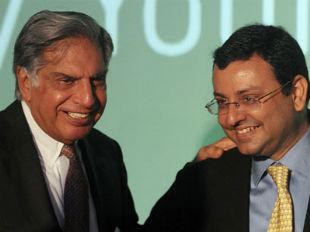
Mumbai, December 28: Ratan Tata, an iconic corporate leader, retired as Chairman of Tata Group after a 50-year run today but kept away from office on his last day at the helm of one of country's oldest business empires.
Tata, who turned 75 today, is in Pune for his birthday, sources at Bombay House, headquarters of the salt-to-software conglomerate, told PTI, adding there was no clarity on whether he would visit his office later in the day.
Chairman-designate Cyrus Mistry, who made a visit to Bombay House today, will tomorrow take charge of the new assignment, sources in Tata Sons said.
Mistry was groomed for the assignment by Tata for a year.
The group had earlier announced that he has been appointed chairman with effect from tomorrow.
Mistry chose the group company Tata Motors entry-level sedan Indigo Manza to travel to work on the important day, marking an end to an era.
The narrow lane leading to Bombay House, one of the oldest buildings in the heritage Fort area of south Mumbai, has heavy media presence since this morning in anticipation of Tata visiting Bombay House.
Ratan Tata, who helmed the group for 21 years after being chosen successor by his uncle, the iconic JRD Tata, in 1991, is credited with transforming the group through bold decisions including large global acquisitions, even as some of its peers struggled to stay relevant post economic liberalisation.
Mistry, who has been with the group since 2006 in various capacities hails from the Shapoorji Pallonji family, the largest private share holder of the group's holding company Tata Sons.
Born on July 4, 1968, Cyrus Mistry completed his graduation in Civil Engineering from London's Imperial College of Science, Technology and Medicine and followed it up with a masters in Management from the London Business School.
He was chosen by a 5-member panel last year to succeed Ratan Tata.
During Ratan Tata's tenure, the group's revenues grew manifold, totalling USD 100.09 billion (around Rs 475,721 crore) in 2011-12 from a turnover of a mere Rs 10,000 crore in 1991.
Tata led the group into some notable acquisitions, starting from Tetley by Tata Tea for USD 450 million in 2000, to steelmaker Corus by Tata Steel in 2007 for GBP 6.2 billion and the landmark Jaguar LandRover in 2008 for USD 2.3 billion by Tata Motors.
Courtesy the acquisitions, over half of the salt-to-software group's revenues are derived from outside the country.
Not limiting himself to big-ticket acquisitions, Tata also displayed sensitivity to the needs of the burgeoning middle class with the launch of the Rs one lakh Nano battling the odds in West Bengal.
The group was forced to shift the project from Singur, where he was invited by Marxist Chief Minister Buddhadeb Bhattacharya, to Sanand in Gujarat at the invitation of Narendra Modi.
Although Nano could not live up to the expectations after its initial worldwide acclaim, the small car will still be remembered as Tata's desire to provide a "safer" option to many Indian lower-middle class families riding two-wheelers.
In a recent interview to PTI, Tata has said that Singur was a "great disappointment" because he went there "in a leap of faith" thinking that part of the country was being ignored industrially. Tatas will still go to West Bengal someday, he has said.
Under Tata, the group also made great strides when it capitalised on the sunrise industry of information technology in the 90's. With revenues of over USD 10 billion in 2011-12, Tata Consultancy Services (TCS) is today India's largest IT company, ahead of giants in the field like Infosys and Wipro.
On his post-retirement plans, Tata, a bachelor, has said he will spend time on technology which is quite a passion with him. He will brush up on his piano, which he learnt as a school boy and pursue flying, apart from his focus on philanthropic activities.





Comments
Add new comment